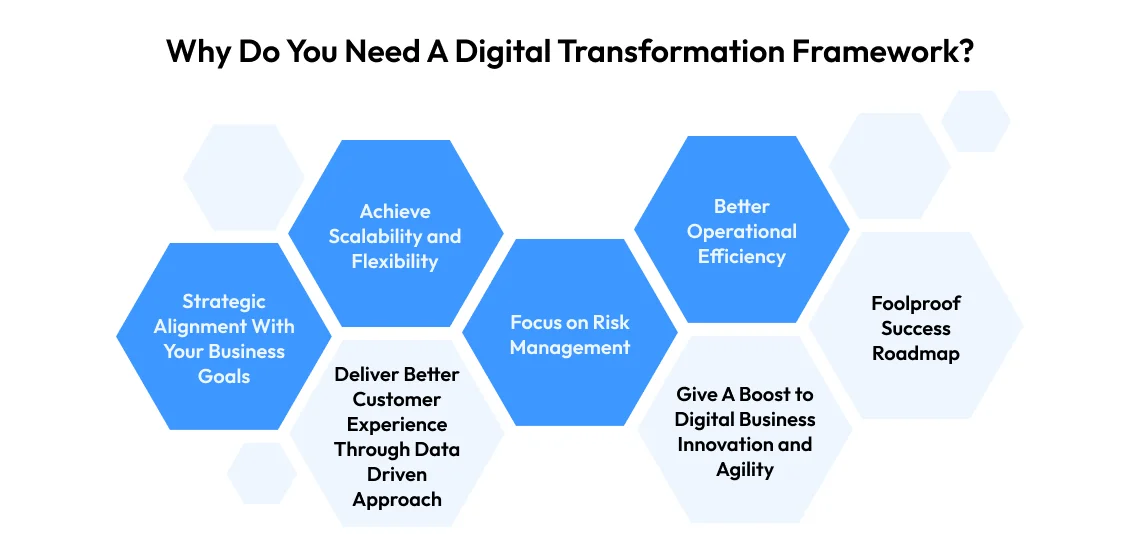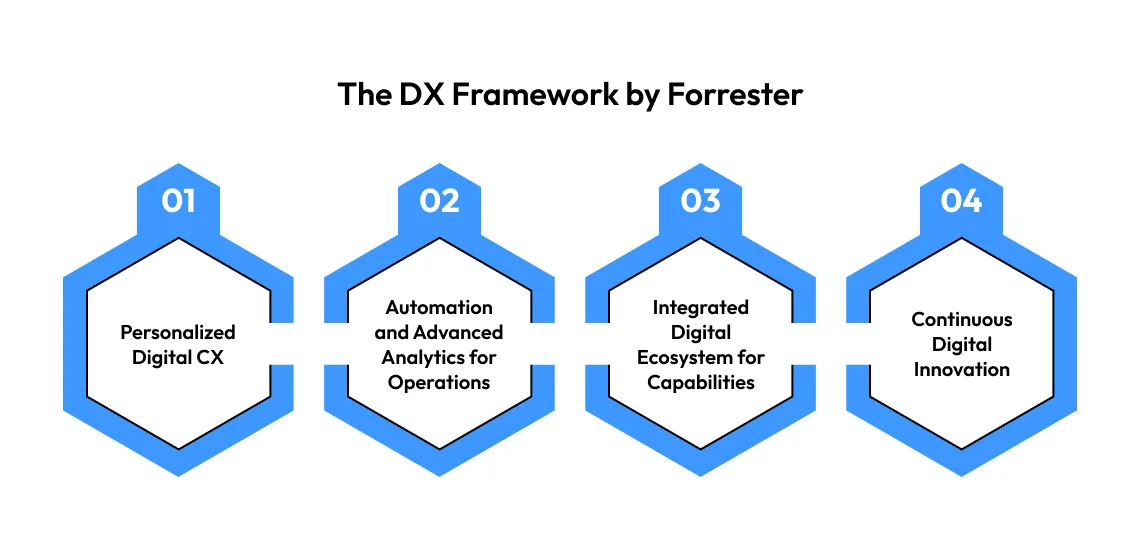How to Choose the Right Digital Transformation Framework for Your Business?
- Business
- June 21, 2024
Digital transformation is a necessity for staying competitive in today’s fast-paced business environment, and this can’t be overlooked. Out of the many digital transformation frameworks available, you should choose the one that drives the most value for your business. This blog provides a comprehensive guide to digital transformation frameworks, essential tools for businesses looking to thrive in the digital age.
“At least 40% of all businesses will die in the next ten years… if they don’t figure out how to change their entire company to accommodate new technologies,” said John Chambers – former executive chairman and CEO of Cisco Systems, at one tech conference. This adds depth to your motivation for building a digital transformation strategy specific to your business.
But you can’t just go around and implement your digital transformation (DX) strategy, you need to find your ideal-fit one among many popular digital transformation frameworks.
Do you think that knowing different digitization strategy frameworks will help you find your ideal one? Nahh!!! Before you begin your quest for finding your digital transformation asset, you first need to go through different phases of digital transformation, the effectiveness of the tools and technologies associated, and best practices to choose the right one.
Well, this blog is all about that! So, let’s dive into our journey to figuring out the best digital transformation strategy framework, your companion to future-ready business excellence.
What is A Digital Transformation Framework?
Consider digital transformation framework as a guidebook to achieve smooth foolproof digital transformation with future-proofness.
While digital transformation refers to the integration of digital technologies into various aspects of a business to fundamentally change how the organization operates and delivers value to customers, digital transformation framework refers to a structured approach or methodology that organizations follow to plan, implement, and manage digital transformation initiatives effectively.
In short, digital transformation frameworks provide a roadmap for leveraging digital technologies to drive organizational change, improve processes, enhance customer experiences, and achieve strategic objectives.
There’s no universal digital transformation framework you can refer to, as different businesses have their own complexity and need unique solutions. Hence, you need to first understand your business goals and different digital transformation frameworks to find your direction.
Why Do You Need A Digital Transformation Framework?
In one survey, McKinsey revealed that around 70% of large-scale transformations struggle to reach their goals due to not having a well-structured framework in place. So, let’s have a look at the features of frameworks that motivate your DX initiatives:

1. Strategic Alignment With Your Business Goals
A well-crafted digital transformation strategy includes every aspect of your business goals and digital possibilities, along with implementation strategies and technologies to leverage. While crafting one, you should not miss out on anyone. Hence, the digital transformation assessment framework comes to your rescue, helping to align business goals with digital initiatives.
Our favorite coffee brand, Starbucks has increased sales with mobile app development. This initiation included its digital transformation strategy to enhance customer experience with conveniences and operational efficiency. This move not only increased customer satisfaction but also boosted sales and reduced customer wait time to receive their orders.
2. Achieve Scalability and Flexibility
Digital transformation strategy framework often incorporates future plans to scale as needed with flexibility, allowing businesses to grow and adapt to changing market conditions. With this, businesses can deal with market and digital challenges when and as needed.
Netflix transformed from a DVD rental service to a leading streaming platform by leveraging a flexible and scalable digital framework. The company adapted its technology infrastructure to support a global audience and a vast library of content, allowing it to scale efficiently as demand increased.You should also know Netflix’s app development strategy and how it’s leading the on-demand video streaming marketplace.
3. Deliver Better Customer Experience Through Data Driven Approach
In today’s world, data is your biggest asset, and harnessing its potential is important. Considering that, you can leverage data science for data-driven decision-making in your digital transformation strategy. Digitization strategy framework incorporates tools and methodologies for gathering and analyzing customer data to drive better decision-making.
When it comes to understanding customers, Amazon leads the way. No wonder why Amazon has made 143.31B of business in this March 2024 quarter only.
It has information on everything, what customers search for, how they behave and navigate, and more. Utilizing all data studies, it provides personalized recommendations and targeted marketing, significantly improving customer satisfaction and retention.
4. Focus on Risk Management
The digital world with conveniences also offers chills like cybersecurity threats, data management considerations, etc., which you don’t want to take for your business. That’s where digitization methodology helps you focus on robust risk management strategies to identify, assess, and mitigate potential risks.
If we speak about real-life examples of digitization strategy framework for risk management, JPMorgan Chase comes out as a notable candidate. It has adopted a digital transformation framework to enhance cybersecurity and compliance by implementing advanced analytics and monitoring tools to detect and respond to fraudulent activities in real time.
5. Better Operational Efficiency
Digital transformation is your gateway to operational efficiency if executed correctly and the framework for the same is your guide to get that breakthrough. It enables you to have tons of digital technological possibilities to put your business in automation mode or minimize your efforts by up to 50-70%.
Among others, Siemens has also adopted a digital transformation framework with that motivation. This guide helped it implement IoT and data analytics into its operations, which resulted in reduced downtime, improved maintenance schedules, and enhanced overall productivity, leading to cost savings and higher efficiency.
6. Give A Boost to Digital Business Innovation and Agility
Digital transformation in itself is a gateway and offers agility to adapt to the latest tech innovations and stand out from the market. A well-structured DX framework fosters a culture of innovation helping businesses to stay relevant with the tech market dynamics.
The revolutionary on-demand music app – Spotify, also uses the DX framework to experiment with new app features, themes, and strategies to stay ahead of the ahead in the competitive on-demand online music streaming industry.
7. Foolproof Success Roadmap
When considering a digital transformation framework for your digital journey, you should be at ease as it covers clear milestones, deliverables, and performance metrics to guide the transformation journey.
Most digital leaders have taken the help of DX frameworks to achieve success in their mission, and your business could be the next as well.

Popular Digital Transformation Frameworks You Can Consider
Let’s have a look at popular digital transformation frameworks you can consider for your DX mission or opt for if feel like such can help you in your mission:
The DX Framework by Forrester
Forrester’s DX framework mainly focuses on customer experience and expectations. It emphasizes a customer-centric approach and integrates digital capabilities across the organization to drive value.
Some of its key values include:
- Seamless, personalized digital customer experiences across touchpoints.
- Leveraging automation and advanced analytics to streamline operations.
- Promote tech accompanies to enhance digital capabilities.
- Fostering a culture of continuous innovation and leveraging new technologies.

Understanding the importance of Forrester’s DX framework, Adobe has also somewhat similar framework to become the digital leader in art and graphics in the world.
McKinsey’s Digital Transformation Framework
McKinsey always values clear targets, leadership endorsement, and capturing the market as the core features of digital transformation success. Following its value, around 16% of business leaders have seen positive impact in their business performance around those values along with a rise in clear communication.
Its framework emphasizes a holistic approach to digital transformation, focusing on integrating digital technologies with business strategy to achieve sustainable growth.
Key takeaways from McKinsey’s DX efforts:
- Aligning digital initiatives with overall business strategy and fostering innovation.
- Enhancing customer interactions through digital channels and personalized experiences.
- Streamlining operations through automation and improving efficiency.
- Implementing the right digital tools and technologies to support transformation.
- Building a digital-ready culture and upskilling employees.
Gartner’s Digital Business Transformation Framework
Gartner’s framework provides a structured approach to digital transformation, focusing on integrating digital business strategies with technology implementation to drive business outcomes. Its steps go like as mentioned below:
- Ambition: Define your digital business goal and initial strategy, considering a broad organizational setup.
- Involve Key Stakeholders: Gather the right mindsets behind DX strategy, including digital strategists, marketing leaders, and digital business unit leaders.
- Design: Evaluate digital business possibilities, identify new business revenue streams, seek DX partnership, and cross-check your findings as per CX and business needs.
- Deliver: Scope transformation impact, identify the right DX talents, and opt for MVP development.
- Scale: Plan governance shift with impact, plan future digital business scaling strategy considering pilots and MVPs.
- Refine: Assess the DX framework, evaluate the impact, optimize where required, and reset the strategy and plans reflecting the journey.
These are the main digitization strategy frameworks that businesses often consider adopting for their journey. However, there are many also you can consider, such as Accenture’s holistic framework, the lean DX framework, and Cognizant’s Digital Transformation Framework.
In essence, you can say that all have one goal in common, which may create confusion and dilemma in choosing the right now. Hence, the latter section is all about that.
If you’re unsure and need inspiration from businesses that have driven their growth through digital transformation, explore our blog on “7 Examples of Digital Transformation” That Inspire Businesses to Evolve.
How to Choose The Digital Transformation Framework For Your Business?
One study by Fujitsu revealed that around 76% of businesses rate digital transformation as moderate to extremely challenging. And the biggest reason behind that is not having awareness of the digital transformation frameworks.
Hence, you can fall short for not having an awareness about digital transformation methodology and digitalization framework. Let’s evaluate your ideal-fit DX framework:
Assess Your Business Needs
- Start by thoroughly understanding your business’s current state and specific needs.
- Identify business operational pain points like where it’s lagging, opportunities for improvement, and strategic goals you can take.
- Evaluate your business’s digital maturity, existing processes, and technological capabilities.
Evaluate Digital Transformation Frameworks
- Research, find out, and compare digital transformation frameworks to find the ideal one aligned with your business values.
- For quick help, you can also consider frameworks that we have explained in the previous section.
Customize a Digital Transformation Framework
- Your business would be having unique challenges, and hence, there will be a need for customizing the selected digitalization framework accordingly.
- You also have to adapt the framework’s components, methodologies, and tools to address your specific business challenges and objectives.
How to Implement Your Business-specific Digital Transformation Framework?
As we said earlier, there’s no one-size-fits-all framework to leverage for your digital transformation (DX) mission. However, you can always mix-match and prepare a suitable framework for digital transformation that influences your business strategies. So, let’s know the steps to implement your business-specific DX framework:
Planning and Strategy Development
- At first understand your business maturity level and clearly define what you want to achieve with this digital transformation approach. It could be improving customer experience, increasing efficiency, or entering new markets.
- Establish specific, measurable, achievable, relevant, and time-bound (SMART) goals to track progress.
- Create a detailed plan outlining the steps, timeline, and resources needed for the transformation, including key milestones and deliverables.
Building a Digital Culture
- Ensure the active involvement of the top committee members, also known as stakeholders, with your digital transformation initiatives.
- Involve employees at all levels in the planning process to gain buy-in and foster a sense of ownership.
- Invest in employee training programs to get used to the digital transformation initiatives and understand the framework to utilize it to its full potential.
- Foster a culture of innovation and experimentation and welcome a culture of adaptation of new technologies and processes.
Technology Integration
- Based on your business digital transformation requirements, look out for the modern technologies you can integrate seamlessly with your business processes.
- Implement robust data management practices to ensure data accuracy, security, and accessibility.
- Opt for scalable and flexible solutions that can grow and adapt to your business needs.
- Secure your all-digital solution end-points from potential cyber threats and offer a worry-free utilization of digital enablements.
- Do take the help of advanced AI/ML solutions to leverage data and automate business processes potentially.
Process Optimization
- Design your DX framework to identify process inefficiencies and offer streamlining solutions for better outcomes.
- Fuel your digitalization framework with automation capabilities to automate repetitive, tiring tasks and focus on more strategic tasks.
- Incorporate it with KPIs (Key Performance Indicators) to observe processes to identify inefficiencies and optimize them where required.
Monitoring and Continuous Improvement
- Include regular reviews and feedback cycles of digital transformation initiatives to ensure that digital transformation efforts are on track and delivering the expected benefits.
- Always keep room for improvement and add-ons to improve the DX efforts and keep it abreast of emerging technologies and industry digital transformation trends to ensure your business remains competitive.
How MindInventory Comes In
Having the right digital transformation principles or framework in place has an added advantage to your DX initiatives. However, choosing and building the right one aligned with your business motives requires the help from the digital transformation services provider.
When it comes to choosing the right digital transformation partner, you need to consider many things like experience, results delivered, approach, and more. When in search of a reliable one, MindInventory always gets the spotlight on with a proven track record of delivering smooth digital transformation with a strategic, value-driven approach.
So, are you ready to get your ideal-fit DX framework to excel in your digital initiatives? Let our experts hear your challenges and offer you a proven solution to help you succeed in your mission.
FAQs on Digital Transformation
The four pillars of digital transformation are technology, data, processes, and culture: technology enhances capabilities, data drives decisions and personalization, optimized processes streamline operations, and culture fosters a digital-first mindset and continuous improvement.
The different types of digital transformation include process automation, business model transformation, domain transformation, and cultural/organizational transformation.
To find the right digital transformation partner, evaluate their expertise, experience, and alignment with your business goals and culture.













